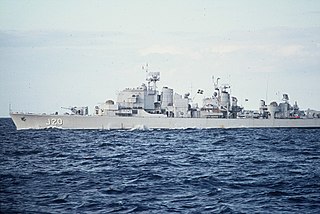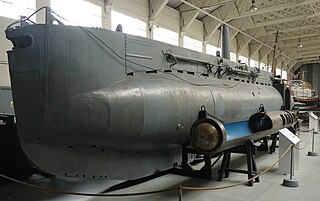
HSwMS Sjölejonet was the lead ship of a class of nine naval submarines in the service of the Swedish Navy from just before World War II into the early Cold War. The submarines were ordered in response to the rising German threat to the south in the interwar period. Sjölejonet remained in service until 1959 and was sold for scrap in 1962.

HSwMS Tre Kronor was a cruiser built for the Royal Swedish Navy during the Second World War.

The ships of the F120 Köln class of frigates were the first major warships built in Germany after World War II.
The Rapp-class torpedo boats were a class of six torpedo boats built in Norway for the Royal Norwegian Navy from 1952 to 1956. They were the first Norwegian-built torpedo boats after World War II, and were designed in light of experience from operations in this war. The boats were slightly larger than the Elco class.

The Tre Kronor class was a class of two cruisers built for the Swedish Navy during World War II, comprising Tre Kronor and Göta Lejon. Tre Kronor was discarded in 1968 and Göta Lejon was sold to Chile in 1971. Renamed Almirante Latorre, she remained in service until being discarded in 1986.

HSwMS Göta Lejon was a Swedish cruiser. Together with her sister ship Tre Kronor, they were the largest ships ever to serve in the Royal Swedish Navy. In 1971 Göta Lejon was sold to Chile where she was renamed Almirante Latorre and served in the Chilean Navy until 1984. She was sold to Taiwan in 1986 to be scrapped.

The Natsushio-class submarines were a pair of submarines constructed and operated by the Japan Maritime Self-Defense Force during the Cold War. They were a development of the Hayashio-class submarines and are sometimes considered the same class. They were small and limited in capability but were thought to be a successful class. They entered service in 1963–1964 and were deleted in 1978.

The Jacob van Heemskerck-class frigate was a class of frigates of the Royal Netherlands Navy. They were designed to be an air defence version of the Kortenaer class. The helicopter was replaced by a Standard medium range surface-to-air missile (SAM) system and associated radars. Two ships were built for the Royal Netherlands Navy. In 2005 they were sold to the Chilean Navy.

The Östergötland class were a class of destroyers built for the Swedish Navy in the late 1950s. They were smaller and less capable than the preceding Halland class and were decommissioned in 1982. The class were the last destroyers built by Sweden in the 20th century. They were sometimes referred to as Light destroyers.

The Stickleback-class submarines were midget submarines of the British Royal Navy initially ordered as improved versions of the older XE-class submarines. They were designed to allow British defences to practice defending against midget submarines since it was theorised that the Soviet Union had or could develop such craft.
The Finnish Navy used several different types of motor torpedo boats during World War II. Four Soviet motor torpedo boats were captured and commissioned by the Finnish Navy during the World War II. One of these was of larger D-3 class while three others belonged to G-5 class.

The Ruotsinsalmi-class minelayers were a two-strong class of minelayers in the Finnish Navy. The two ships, comprising Ruotsinsalmi and Riilahti, were constructed in Finland and saw service in the Winter War and World War II. Riihahti was sunk in an engagement with Soviet motor torpedo boats on 23 August 1943. Ruotsinsalmi survived the wars and remained in service in the post war Finnish Navy until being withdrawn in the 1970s.

The Sonya class, Soviet designation Project 1265 Yakhont, are a group of minesweepers built for the Soviet Navy and Soviet allies between 1971 and 1991.

HSwMS Näcken is the lead ship of her class of submarine for the Swedish Navy. She was launched at the Kockums shipyard in Malmö, Sweden, on 17 April 1978, and completed and commissioned into the Swedish Navy in April 1980. From 2001 to 2005, the submarine was leased to the Royal Danish Navy and operated as HDMS Kronborg (S325). She was restored to her original name of Näcken upon her return to Swedish control. She was scrapped in Karlskrona during 2015–2016.

The Göteborg class was a Swedish World War II destroyer class. Built from 1936–1941 the class was designed as escort and neutral guard destroyers. In total six ships were constructed, HSwMS Göteborg, HSwMS Stockholm, HSwMS Malmö, HSwMS Karlskrona, HSwMS Gävle and HSwMS Norrköping. After World War II the destroyers, later rebuilt as frigates, continued to serve in the Swedish navy. The last ship was decommissioned in 1968.

The Pará-class destroyer is a class of destroyers of the Brazilian Navy. Seven ships of the Fletcher class were lent by the United States Navy and were in commission from 1959 until 1990.

HSwMS Neptun is the second of three Näcken-class submarines, built to operate in the Baltic. Neptun entered service in December 1980. The next year she was involved an international incident when the Soviet submarine U 137 ran aground outside Karlskrona.

HSwMS Älvsborg (M02) was a minelayer in the Swedish Navy, launched on 11 November 1969. She had one sister ship, HSwMS Visborg. She belonged to the 1st Submarine Flotilla and served as leader of the division. In 1997, Älvsborg was sold to Chile and was renamed Almirante José Toribio Merino Castro. She was taken out of service on 15 January 2015.
Several ships of the Swedish Navy have been named HSwMS Tordön or HSwMS Thordön, named after the Old Norse word for thunder:

KD Laksamana Tan Pusmah (F137) is the fourth Laksamana-class corvette currently in service with the 24th corvette Squadron of the Royal Malaysian Navy. She built by Italian company Fincantieri based on the Type 550 corvette design.















